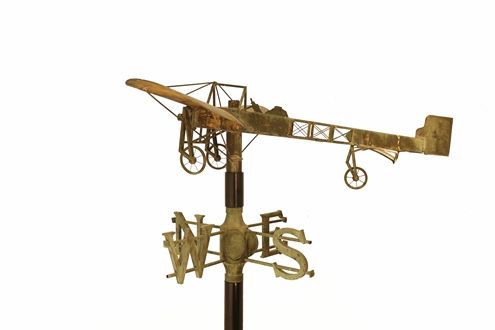
(New York, NY, September 23, 2022) — The Metropolitan Museum of Art announced today that it has received a gift of a rare American weathervane from Michael and Patricia Del Castello. Produced by an unidentified maker between 1909 and 1913, it was likely commissioned for the Poland Spring House, Poland Spring, Maine, where it was installed on its rooftop by 1914 and remained on view until 1973. The commanding and distinctive weathervane joins The Met’s growing collection of American vernacular sculpture, and will be on view in Gallery 732 in the American Wing starting October 10, 2022.
“This weathervane is an extraordinary example of American vernacular sculpture,” stated Max Hollein, Marina Kellen French Director of The Met. “The gift marks an important development as the Museum continues to evolve the breadth of its collecting, especially as the American Wing approaches its centennial year in 2024. We are deeply grateful to Michael and Patricia Del Castello for their generous gift of this unique work of art.”
Primarily used to indicate and measure wind direction, weathervanes represent an American sculptural tradition that dates back to the early 18th century. This weathervane was modeled after the Blériot Model XI Monoplane, a small plane that the French aviator and engineer Louis Blériot (1872–1936) flew across the English Channel on July 25, 1909, marking the first airplane flight across the channel, 25 miles from Calais to Dover. Blériot helped design the plane and put it into production, setting records for flying speed, altitude, and distance. The plane was popular in races in both Europe and the United States. The weathervane representing the monoplane presumably was made in response to races held between French and American aviators in Poland Spring and Portland, Maine, sometime after Blériot’s historic 1909 flight across the English Channel.
“The gift of the Blériot Model XI Monoplane weathervane is transformative as it adds to the collection one of the most sophisticated examples of American weathervanes ever produced,” said Thayer Tolles, Marica F. Vilcek Curator of American Painting and Sculpture. “The weathervane is distinctive not only for its commanding scale and complexity of assembly, but also its reference to a historical event.”
About The Met
The Metropolitan Museum of Art was founded in 1870 by a group of American citizens—businessmen and financiers as well as leading artists and thinkers of the day—who wanted to create a museum to bring art and art education to the American people. Today, The Met displays tens of thousands of objects covering 5,000 years of art from around the world for everyone to experience and enjoy. The Museum lives in two iconic sites in New York City—The Met Fifth Avenue and The Met Cloisters. Millions of people also take part in The Met experience online. Since its founding, The Met has always aspired to be more than a treasury of rare and beautiful objects. Every day, art comes alive in the Museum’s galleries and through its exhibitions and events, revealing both new ideas and unexpected connections across time and across cultures.
###
September 23, 2022
Contact: Stella Kim
Communications@metmuseum.org
Image: Blériot Model XI Monoplane weathervane, ca. 1909-13, copper with traces of original gilding; airplane: 57 ¼ x 55 x 10 in. (145.4 x 139.7 x 25.4 cm), directionals: 38 5/8 x 38 ½ x 15 ¾ in. (98.1 x 97.8 x 40 cm), The Metropolitan Museum of Art, Gift of Michael and Patricia Del Castello. Photo credit: Michael Kent Lynberg.
Press resources